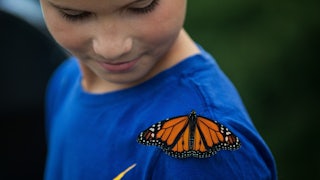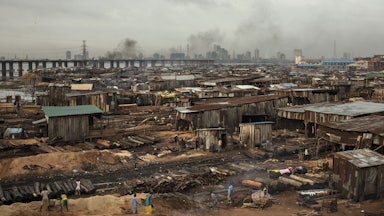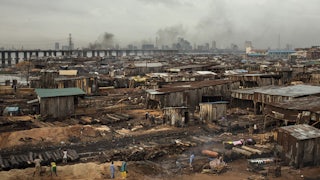With an average of 16 feet of snowfall per year, Sapporo, Japan is one of the snowiest places on earth. But at the last Sapporo Snow Festival, for the first time in its 70 years of existence, the festival had to import truckloads of snow from even snowier regions in the mountains due to a record snow shortage. “If global warming continues as is, we won’t be able to make snow sculptures in Sapporo, it may not even be possible to hold the festival in the future,” Shinji Mae from the Sapporo Snow Festival’s executive committee told me. Japan’s snow depth is declining at a rate of 13 percent per decade under the climate crisis.
In the past week, global warming’s threat to winter sports has become particularly obvious as the world watches the Beijing Winter Olympics—the first ever winter Olympics without any natural snow. But mountain towns and winter sports enthusiasts all over the globe have known about this problem for a while.
The American West has also been hit hard, with the mountains there losing 20 percent of their snowpack since the 1970s. By the end of the century, the Rockies, the Sierra Nevada, and the Cascades could stand to lose another 50 percent. Mario Molina, executive director at nonprofit climate advocacy group Protect Our Winters, based in Boulder, said these changes are already apparent. “What we see is the unpredictability of the winter season across the country. We’re no longer able to rely on the onset of winter toward the end of November,” said Molina. The unthinkable happened this past December when fires broke out in Boulder county.
Climate change has cut snow seasons shorter than ever. Local residents, powder-lovers, and the whole winter sports industry are now wondering: Could we only have a limited number of good snow seasons left?
While the interaction between human-induced climate change and warming temperatures is clear-cut, the relationship between warming temperatures and snow is more complicated than it appears. There are two variables to pay attention to: snowfall, which is the amount of precipitation that falls as snow in a given year, and then snow cover or snowpack, which is the extent of land covered by snow. David Robinson, professor at Rutgers University and the New Jersey state climatologist, whose research focuses on snow cover in the Northern Hemisphere, said that there haven’t been as strong snowfall signals as one might expect under warming.
“In fact, some would say we have had mixed messages with these large snowstorms,” said Robinson. “The warmer the air, the greater potential moisture it can hold. So you can get more snow out of a 30-degree snowfall than a 20-degree snowfall.”
/ In honor of Earth Day, Apocalypse Soon content is free to registered users until April 29. Start reading now.
According to data from the Environmental Protection Agency, more southern regions such as Virginia, Arizona, and California have already lost a lot of snowfall, as opposed to states like Michigan and the Dakotas, where there have been no change or small gains in snowfall. But the overall snow cover trends aren’t positive: Between 1982 and 2016, levels of snow cover saw an average drop of 41 percent in the United States. But with unabated emissions, declines in both snowfall and snow cover will shift further and further north as the century winds on, threatening winter sports as far north as Calgary, Vancouver, and Oslo by the 2080s, per a study from the University of Waterloo.
Less snow in turn will have huge repercussions for the climate, economy, and society. “Once you get snow on the ground, it then has an influence on weather and climate patterns, driving cold air masses, reflecting solar radiation to keep conditions colder, and so on,” said Robinson. “Snow responds to climate variables and in turn drives new climate variables.”
The effects on water resources are by far the most significant, with hundreds of millions of people around the world from California to India relying on water from mountain snowpack. Poor snow years in the U.S. also decrease economic value added by $1 billion and cost 17,400 jobs compared to the average snow season, according to Protect Our Winters. “This has downstream implications for the livelihood of people depending on that revenue—ski-lift operators, hotels, restaurants, the service industry,” said Molina.
Robert Steiger, an associate professor at the University of Innsbruck who studies the effects of climate change on winter sports and tourism, says there are locations where climatic conditions for snow will be lost within the next decades, but others that will still have reliable winters by the end of the century. Overall, “winters that were extraordinarily snow-scarce would be close to an average winter toward the end of this century,” he said. In essence, these projections tell us that there will still be good winter seasons in the 2050s and even 2080s, but they’ll become much rarer and more location-dependent.
This is already translating into a lot of anxiety for mountain residents and winter sports enthusiasts. Caroline Gleich, a professional ski mountaineer based in Park City, Utah, has experienced changes to winter firsthand across the world. “In the past, you’ve been able to depend on historic weather data to help you decide the best time of year to go skiing in different places,” she said. “These patterns are no longer holding. The ski season is more erratic, more dangerous.”
Gleich has completed expeditions to high-altitude tropical glaciers in Peru and the Himalayan glaciers, and was shocked at how quickly they were melting. “Instead of first descents, people could be doing their last descents,” she said. “Confronting the reality of the climate crisis definitely brings me huge waves of depression and anxiety. I’m in my midthirties, and I have a lot of friends who haven’t started families because of depression, anxiety, and concern for future generations. It’s something my friends and I talk about a lot.”
Aspen, one of the most famous ski towns in America, has lost roughly 30 days of winter since 1980, according to Auden Schendler, senior vice president of sustainability at Aspen Snowmass, which operates four ski resorts in Aspen. “We have the same opening because we’re at a high elevation and we have snowmaking,” he says. “I would say most resorts are increasing snowmaking, and that is their whole response. A lot of operators think, ‘What am I supposed to do?’” The crux of Aspen Snowmass’s climate response has been to increase snowmaking, expand summer revenue, and work toward collective political action, getting involved with congressional races to support politicians who are willing to take action on climate. “I’m not optimistic about the ski industry,” Schendler said.
Hand-wringing over the fate of skiing can come across as out of touch, given the sport’s reputation for inaccessibility to all but the wealthy and (often) white. Winter sports enthusiasts and industry advocates have a variety of responses to that. Schendler, for instance, points out that skiing is one of many pleasures global warming will wipe out in addition to presenting more existential threats: “Human beings need a break,” he said. “Climate change takes away that joy, and makes us turn into a survival society.”
Declining snowfall also means a lot more to mountain communities than a loss of recreation. Rob Writz, founder of Front Range Skiimo, who leads skiing and mountaineering tours in Colorado’s front range, is less concerned about the loss of skiing, which he views as a privilege. “I am more concerned with increasing water scarcity intersecting [with] the growing population,” Writz told me. “Droughts are frequent here, and as the summers become hotter and longer, the potential to capture and harvest water from snowfall becomes more challenging.”
Not all winter sports–industry insiders are worried. Butch Martin, manager of North Elba Park District, which includes Lake Placid, a popular ski area in New York, has been involved in activities in the area for over 50 years, including the toboggan slide, the skate path, and the pond hockey tournament on Mirror Lake. Martin says that weather has been average over the last decade and colder and harsher than usual in recent years. “Climate change may be a factor with Mirror Lake, but I am not sold on it,” Martin says. “For the future, we will always keep our eyes and ears open to research and projections, but each year we will plan to operate as the weather allows. Personally I do not have climate anxiety, I just take things one day at a time.”
But there’s an increasing trend toward environmental activism among winter athletes and mountain lovers. In 2007, professional snowboarder Jeremy Jones founded Protect Our Winters to mobilize the sports community on climate change. The organization now operates in 40 countries and has started focusing on climate messaging in key congressional districts: With 50 million people estimated to be involved in outdoor recreation annually, the pool of potential activists that could be mobilized, the group thinks, could be huge. Molina views his work with the organization as a way to turn anxiety into action. “Hopefulness and gratitude are two attributes that you have to hold dear when you’re involved in this type of work,” said Molina. “We have a short but real window to take significant action and address the worst of the impacts. We know we have the technological capacity and the financial instruments to address this—what we’ve been lacking so far is the political will.”
Schendler has told numerous journalistic outlets in the past few years that he wants the outdoor community to mobilize as aggressively as the National Rifle Association, which has an outsize impact on American politics despite being less than one-tenth of the size of the outdoors community. “Why wouldn’t this group of people, all of whom are environmentalists to one degree or another, become a movement, a climate movement, which is taking out all the things that these people love?” he told me.
Warming winters threaten winter recreation and snow culture around the world: snow festivals in Sapporo and Harbin, skiing in the Alps, mountaineering in the Rockies and the Himalayas. “If there’s one place to be spending our time and energy, it’s voting and getting others registered to vote,” said Gleich. “The net pollution reductions we can achieve by voting and engaging in systemic actions are far greater than going to these great extents to get our carbon footprints down to zero.”
Heavy snow isn’t going to disappear from the world overnight. Winter and snow lovers will have to take advantage of conditions when they do exist, without assuming those conditions will stick around. As the snow shifts ever so slightly north in each passing year without drastic climate action, it marks another steady tick in the destabilization of snow culture.
“I think optimism is an outdated word,” said Schendler, when I asked him about his mindset for tackling the climate crisis. Action isn’t necessarily about optimism or pessimism, he said: “It’s about what human beings have always done, which is fight impossible battles.”










